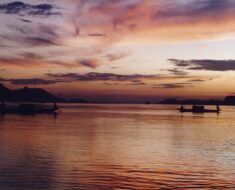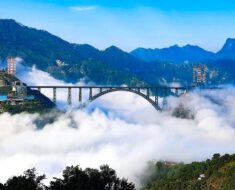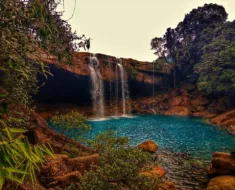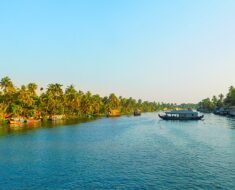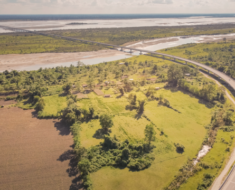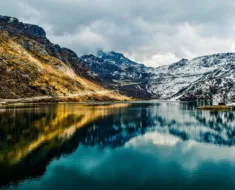The northeastern state of Manipur is one of the most beautiful seven sister states and is known for its dance forms, music, traditions, and rich culture. Manipur literally means the land of gems or the jeweled land.
Manipur is also referred to as ‘Kangleipak’ or ‘Meiteilepak’ by the locals in the Meitei language. Meitei is the majority ethnic group of Manipur. Nearly half of the people living in the state are Meiteis.
Here is a list of facts about Manipur that will surely motivate you to visit this unexplored region of northeastern India.
1. Manipuri Dance
Manipuri Dance is among the eight major classical dance forms in India. It is a traditional classical dance form that originated in Manipur.

Legends say that the people of Manipur are originally Gandharvas –the celestial singers and dancers. And the origin of Manipuri dance can be traced back to ancient times that go beyond recorded history.
The Manipuri dance is associated with the cultural heritage and traditional festivals of the Manipuri.
It was during the reign of King Rajarshi Bhagya Chandra in the 18th century that the popular Rasleela dances of Manipur originated. His daughter Shija Lailoibi played Radha at the first performance.
In Manipuri Rasleela, the main characters are Radha, Krishna, and the gopis and themes often depict the pangs of separation of the gopis and Radha from Krishna.
💡 Travel Tips: 10 Best Places to Visit in Manipur
2. Ima Market
The Ima Market is a unique market in the capital city of Manipur, Imphal that is entirely run by women. It is also known as Ima Keithel which literally means Mothers Market.
The word Ima means Mother and there are around 5,000 Imas running their stalls dressed in traditional phaneks (long skirts tightly draped around the waist) and innaphis (shoulder drapes very similar to shawls).

It is also known by some other names like Nupi Keithel or Khwairamband bazaar and is the only market in the world run entirely by women and male shopkeepers and vendors are not allowed to sell anything.
It holds great cultural and historical significance in Manipur and was established in the 16th century and ever since it is a bustling hub of trade and commerce.
According to historians, the Ima market originated after the Lallup-Kaba, an ancient forced labour system which was in Manipur Kingdom that required men to work in distant lands or to serve in the army.
Ima Market is truly a paradise for shopping lovers and a very lively and vibrant market where hundreds of “Imas” sell different products ranging from vegetables, fruits, traditional garments, spices, textiles, toys, and other household items.
Visiting Ima Market is an amazing experience as it is not only an opportunity to shop for unique local products but also a chance to witness the vibrant and rich cultural heritage of Manipur.
Tourists visiting Imphal should never miss this wonderful market and must appreciate the spirit of women in Manipur.
💡 Travel Guide: The Ultimate Travel Guide To Manipur
3. Indian National Army War Museum
Indian National Army War Museum situated in Moirang, Manipur a tribute to the brave soldiers who fought during World War II under the charismatic leadership of Netaji Subhas Chandra Bose.

Moirang Kangla is a significant preserved historical site and is the first place on Indian soil where the Indian national tricolour flag was unfurled on April 14, 1944.
The INA War Museum showcases a collection of artifacts, photographs, letters, badges of ranks of the INA soldiers, Japanese amulets, and other war memorabilia that reminds the visitors of the noble sacrifices made by the INA soldiers.
The museum also features a replica of the original INA Memorial in Singapore.
It stands as a symbol of national pride and visiting the museum educates us about the sacrifices made by our freedom fighters against the British colonial rule.
Read More: 10 Interesting Facts about Assam
4. Birthplace of Modern Polo
Manipur is credited to be the birthplace of modern polo as the current international form of the game is derived from the form played in Manipur. It is known as Sagol Kangjei (Sagol means pony and Kangjei is a hockey or stick made of cane).

Sagol Kangjei is not only a sport in Manipur but it is an integral part of the state’s culture. Imphal Polo Ground is the oldest polo ground in the world at Imphal’s Mapal Kangjeibung. The historical account of this polo ground can be found in the royal chronicle Cheitharol Kumbaba, dating back to 33 CE.
The Father of modern polo Major General Joseph Ford Sherer played on this polo ground in 1850.
The first polo club in India was established in 1834 at Silchar, Assam. Later, in 1862 two British soldiers, Sherer and Captain Robert Stewart founded the Calcutta Polo Club which remains in existence even today.
The British are credited with spreading polo worldwide in the late 19th century and the early 20th century. Military officers imported the game to Britain in the 1860s and established polo clubs throughout England and Western Europe.
5. Loktak Lake
The Loktak Lake is the largest freshwater lake in Northeast India. The pristine lake is located in Moirang near the Bishnupur district of Manipur and is one of the most popular tourist attractions.
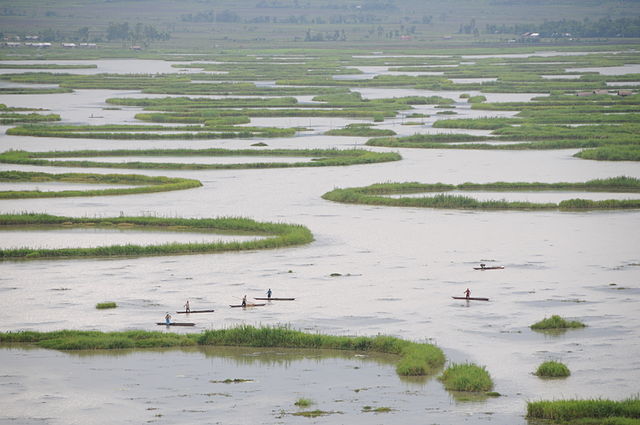
The lake is considered the ‘lifeline for the people of Manipur’ as it plays a vital role in the economy, social and cultural life of the people of Manipur. It is the source of livelihood for the fishermen who live in the surrounding areas and also serves as a source of water for hydropower generation, irrigation, and drinking water supply.
The lake is known for its floating circular swamps which are called Phumdis or Phumshangs in the local language. These swamps look almost like islands and are a mass of soil, organic matter, and vegetation.
On 23 March 1990, it was recognized as a wetland of international importance under the Ramsar Convention.
6. Floating National Park
Manipur has the only floating national park in the world, the Keibul Lamjao National Park located on Loktak Lake. It is an area of low-lying swamps in the Southeastern part of Loktak Lake and covers an area of 40 sq. Km.

It was officially notified as a Sanctuary in 1966 and a decade later, in 1977, it was declared a full-fledged National Park. It is currently under the tentative list of UNESCO World Heritage Sites, under the title “Keibul Lamjao Conservation Area”
The Floating National Park is also the only home to the near-extinct Sangai or brow-antlered deer. Sangai is also known as the dancing deer of Manipur.
Read More: Top 8 Interesting Facts about Nagaland
7. Longpi Black Pottery
The elegant and ancient art of Longpi black pottery is mainly practiced by the Tangkhul tribe in Nungbi village located in the Ukrul district of Manipur.
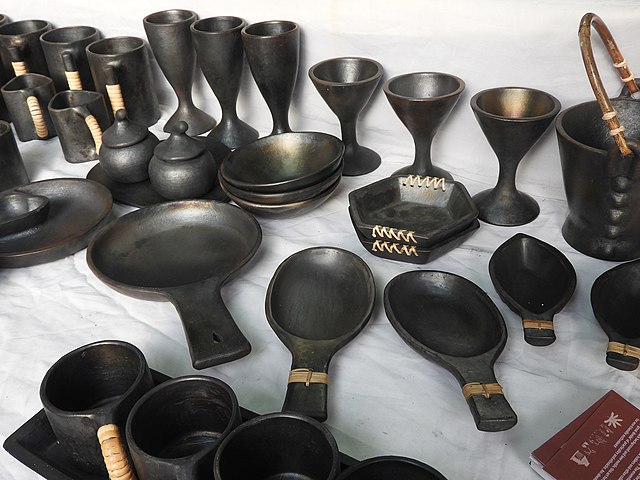
This craft of black stone pottery is said to be handed down from the Neolithic period and this unique form of pottery craftsmen do not use the pottery wheel.
Longpi black pottery is made from a mixed paste of ground black serpentine stone and special brown clay and this clay is only found in Longpi village. This art form of pottery is called Longpi Ham locally.
💡 Travel Tips: The 10 Best Hotels in Manipur
Some More Interesting Facts about Manipur
- Manipur has been inhabited since 30,000 BC, according to archaeological discoveries. The four Khangkhui caverns have been inhabited ever since the stone age.
- The first ruler of Manipur was Nongda Lairen Pakhangba. Around 33 AD, he founded the Kingdom of Manipur.
- Sanamahism is an ethnic religion of the Meitei people of Manipur. It is a polytheistic religion and is named after God Lainingthou Sanamahi. One of the most important deities of the Meitei faith.
- The state animal of Manipur is Sangai, the state bird is Nongyeen, and the state flower is Shirui Lily.
- Manipur is famous for Shirui Lily extremely rare and endangered flower, that is found in its natural habitat on the peak of Shirui Kashong, in Ukhrul district.
- There are 126 kinds of bamboo in India and out of which 53 are found in Manipur. The northeastern state produces over 10 lakh tonnes of bamboo annually.
- The artisans’ village in Andro is a unique attraction to visit in Manipur where you can get to see how the state’s 29 tribal communities go about their daily lives.
- As an Indian citizen, you can enter Myanmar on foot, without a visa, and just for Rs 20 through Moreh.

